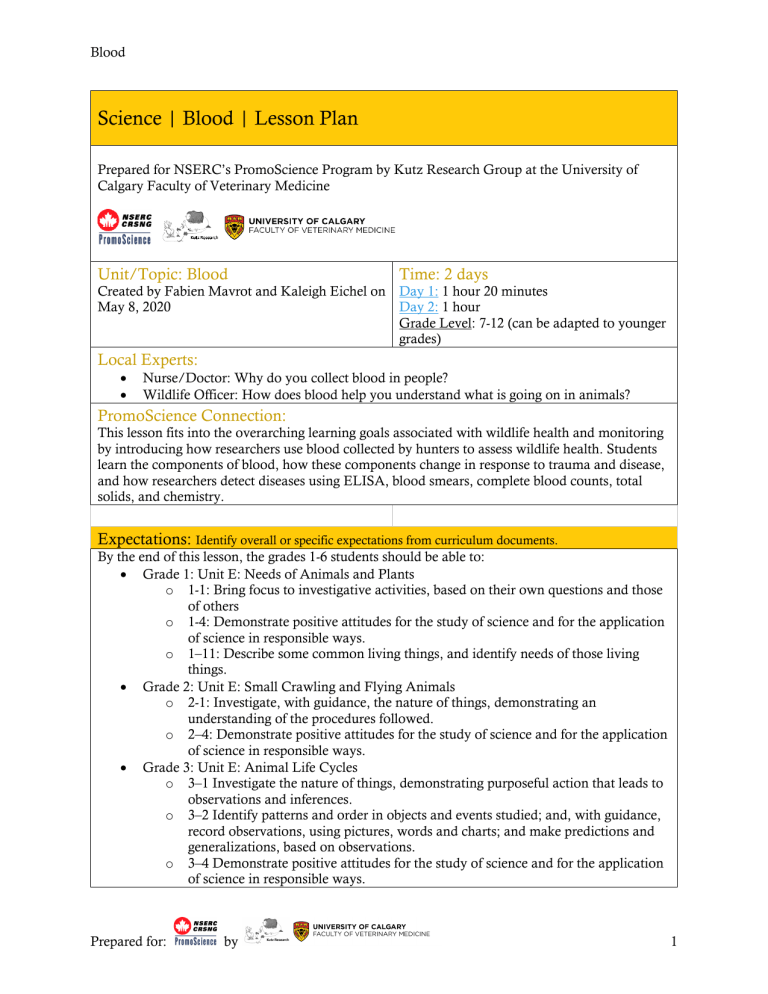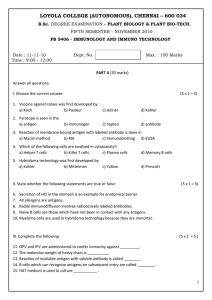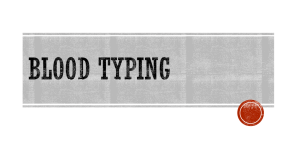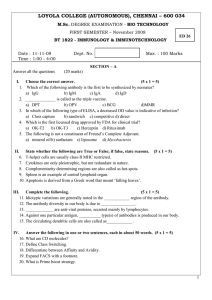
Blood Science | Blood | Lesson Plan Prepared for NSERC’s PromoScience Program by Kutz Research Group at the University of Calgary Faculty of Veterinary Medicine Unit/Topic: Blood Time: 2 days Created by Fabien Mavrot and Kaleigh Eichel on Day 1: 1 hour 20 minutes May 8, 2020 Day 2: 1 hour Grade Level: 7-12 (can be adapted to younger grades) Local Experts: • • Nurse/Doctor: Why do you collect blood in people? Wildlife Officer: How does blood help you understand what is going on in animals? PromoScience Connection: This lesson fits into the overarching learning goals associated with wildlife health and monitoring by introducing how researchers use blood collected by hunters to assess wildlife health. Students learn the components of blood, how these components change in response to trauma and disease, and how researchers detect diseases using ELISA, blood smears, complete blood counts, total solids, and chemistry. Expectations: Identify overall or specific expectations from curriculum documents. By the end of this lesson, the grades 1-6 students should be able to: • Grade 1: Unit E: Needs of Animals and Plants o 1-1: Bring focus to investigative activities, based on their own questions and those of others o 1-4: Demonstrate positive attitudes for the study of science and for the application of science in responsible ways. o 1–11: Describe some common living things, and identify needs of those living things. • Grade 2: Unit E: Small Crawling and Flying Animals o 2-1: Investigate, with guidance, the nature of things, demonstrating an understanding of the procedures followed. o 2–4: Demonstrate positive attitudes for the study of science and for the application of science in responsible ways. • Grade 3: Unit E: Animal Life Cycles o 3–1 Investigate the nature of things, demonstrating purposeful action that leads to observations and inferences. o 3–2 Identify patterns and order in objects and events studied; and, with guidance, record observations, using pictures, words and charts; and make predictions and generalizations, based on observations. o 3–4 Demonstrate positive attitudes for the study of science and for the application of science in responsible ways. Prepared for: by 1 Blood • Grade 4: General Learner expectations o 4–1 Investigate the nature of things, demonstrating purposeful action that leads to inferences supported by observations. o 4–2 Identify patterns and order in objects and events studied; and record observations, using pictures, words and charts, with guidance in the construction of charts; and make predictions and generalizations, based on observations. o 4–4 Demonstrate positive attitudes for the study of science and for the application of science in responsible ways. • Grade 5: General Learner Expectations o 5–1 Design and carry out an investigation, using procedures that provide a fair test of the question being investigated. o 5–2 Recognize the importance of accuracy in observation and measurement; and, with guidance, apply suitable methods to record, compile, interpret and evaluate observations and measurements. o 5–4 Demonstrate positive attitudes for the study of science and for the application of science in responsible ways. • Grade 6: Diversity of Living Things o 6–1 Design and carry out an investigation in which variables are identified and controlled, and that provides a fair test of the question being investigated. o 6–2 Recognize the importance of accuracy in observation and measurement; and apply suitable methods to record, compile, interpret and evaluate observations and measurements. o 6–4 Demonstrate positive attitudes for the study of science and for the application of science in responsible ways. (The NWT Grades K-6 Science and Technology Curriculum (2004)) By the end of this lesson, the grade 7-9 students should be able to: • “Conduct investigations into the relationships between and among observations, and gather and record qualitative and quantitative data.” • “Analyze qualitative and quantitative data, and develop and assess possible explanations.” • “Work collaboratively on problems; and use appropriate language and formats to communicate ideas, procedures and results.” • Grade 8: Unit B: Cells and Systems: “Interpret the healthy function of human body systems, and illustrate ways the body reacts to internal and external stimuli” (Science Grades 7-8-9 Program of Studies 2003 (Updated 2009, 2014) by Alberta Education) By the end of this lesson, Grade 10-12 students will: • “Conduct investigations into relationships between and among observable variables and use a broad range of tools and techniques to gather and record data and information” • “Work collaboratively in addressing problems and apply the skills and conventions of science in communicating information and ideas and in assessing results” • “Formulate questions about observed relationships and plan investigations of questions, ideas, problems and issues” • Unit A: Living Systems Respond to Their Environment: “Analyze how the human circulatory system facilitates interaction between blood cells and the external environment and investigate cardiovascular health” • Unit D: Human Systems: o 2. explain the role of the circulatory and defence systems in maintaining an internal equilibrium (Biology 20-30 Program of Studies 2007 (updated 2014) by Alberta Education) Prepared for: by 2 Blood • Unit C: Disease Defence and Human Health: “Describe the natural mechanisms that protect the human organism from pathogens” (Science 14-24 Program of Studies 2003 (updated 2014) by Alberta Education) Learning Goals: Describe what the students are expected to learn. Share goals with students. Students will learn the basic functions of blood and the basic components of blood. Students will understand why researchers, scientists, and doctors look at blood. Success Criteria: Describe from a student’s perspective what attainment of a learning goal looks like. - Able to explain the functions of plasma, red blood cells, white blood cells, and platelets. Able to describe how coagulation of blood works Able to identify a red blood cell and white blood cell on a microscope slide. (Grades 7-12) Describe how some diseases can be diagnosed from blood analysis. (Grades 7-12) Pre-assessment: Describe links to prior knowledge What makes up the cardiovascular system? What does a heart do? What do blood vessels do? What does blood do? Learning Environment: Describe the setting including groupings and management strategies Environment: Classroom or lab with a sink, computer, projector for PowerPoint Equipment and Materials are available and prepared: - Blood filter paper example - Materials for activity 1 (Making blood): See page 7 - Materials for activity 2 (Blood clots): See page 8 - Materials for activity 5: (Blood smears): See page 12 Management considerations: Safety: Wear personal protective equipment (PPE) for all activities. Wash hands with soap at the end of each lab session. Accommodations: Students will be reminded that they need to work well with the individual they choose and if their grouping is not working out, they will have to work independently (for students who would prefer to work independently, additional worksheets and clipboards will be on hand). Teacher will circulate and monitor students to ensure understanding. o For students with processing issues and or ESL/ELL students, considering making pairs that will provide these students with a lab partner that will help them to be successful. o For students with high levels of anxiety, particularly OCD, consider providing a copy of the lab protocol for students to look over prior to the lesson or discuss with the student which questions will be asked so that the student can prepare for discussions involving bacteria growth and cleanliness - For students with ADHD, ADD or other focus issues, consider “chunking” the lessons and spreading them out so that one part occurs before a recess/ break and the second part occurs after recess/ break, with a brief recap to reinforce ideas from the first part of the lesson Prepared for: by 3 Blood • This lesson is designed for grades 7-12. The lesson can be adapted for grades 1-6 by doing activities 1 and 2, using simpler language, and focusing on observational skills during the demonstrations. Instruction Day 1 Time Introduction “Minds on”: Brief review of the cardiovascular system. Discuss with the class: What makes up the cardiovascular system? What does a heart do? “Action Piece”: Have the class stand up and do jumping jacks or run in place for 30 seconds. “Minds on”: Why did you heart speed up when you were exercising? What do blood vessels do? What does blood do? (To encourage answering questions, you can give out candy to students who participate.) Research Connection In research with wildlife, we collect blood to learn about how well an animal is. We can learn if the animal is stressed by looking at a hormone called cortisol. We can learn if they are sick by looking at the number and type of blood cells present. We can even see if there are germs in the blood, micro-organisms like bacteria and parasites. We can tell if something is wrong with different organs like the kidneys, liver, and intestines. (if time allows, can also discuss function of liver and kidneys). Explain how you use blood filter paper from hunters to learn about animal health. • Today, you are going to learn about what is in blood and then you are going to be a pathologist for a day. Does anyone know what a pathologist is? Pathologists diagnose diseases by looking at blood samples and other parts of the animal, such as urine, hair, skin, and other tissue or fluid samples. 5 minutes 5 minutes Community Connection Ask the nurse/doctor or wildlife officer why they care about blood. How does blood tell you what is wrong with a patient or animal? Give an example of a disease that you can identify by blood (eg diabetes, kidney failure, sepsis). 20 minutes Section 1: Functions and components of Blood (Grades 1-12) “Minds on”: Let’s take a look at blood. Go to PowerPoint for the components of blood presentation. While presenting the components, you can make blood soup step by step. “Action Piece”: Activity 1: Blood Soup (demonstration or students work at desks in pairs, see below) 20 minutes Section 2: Blood Clots (Grades 1-12) “Minds on”: What happens when you get a paper cut or skin your knee? You bleed because the walls of the blood vessel have been broken. But eventually, the bleeding will stop. How does this happen? The secret is in the platelets! Go to PowerPoint presentation. Prepared for: by 4 Blood “Action Piece”: Activity 2: Blood clotting cheese curds (demonstration, see below) “Minds on”: What are Antibodies? What do they do? Go to PowerPoint. “Action Piece”: Activity 3: Antibody Saves the day: Antibodies vs Antigens “Minds on”: Detecting antibodies in the blood using ELISA. Go to PowerPoint. “Action Piece”: Activity 4: You Sunk My ELISA: How do ELISAs work to find positive samples? “Consolidate”: What are the functions of blood? What are the components of blood? How does blood clot? Why do scientists, researchers, doctors, and nurses look at blood? EXIT TICKET: Name 1 new thing that you learned today. 15 minutes 10 minutes 5 minutes Day 2 Section 3: Diagnosing Diseases from Blood (Grades 7-12) “Minds on”: Recap: We have been talking about the components of blood. What are they? What were the red jelly beans? What were the marshmallows? What were the sprinkles? What was the water with sugar and salt and protein powder added? Today we are going to look at blood under the microscope. Community Connection “Mind on”: Ask the local expert how they analyze blood (filter paper, microscope slides, get back a lab report about what is in the blood). “Action Piece”: Activity 5: Prepare a blood smear (skip this step if you are using prepared blood smears, or prepare blood smears ahead of time) “Minds on”: Identify abnormal cells on the powerpoint while we wait for the slides to dry. “Action piece”: Activity 6: Let’s look under the microscope. PowerPoint or handout with the different parts of blood labelled. The teachers and local experts can walk around and explain the underlying disease and why it is causing the abnormalities that they see. “Consolidate”: What disease did you see under the microscope? Why did it look different from normal blood? EXIT TICKET: Name 1 new thing that you learned today. 5 minutes 5 minutes 15 minutes 5 minutes 25 minutes 5 minutes Assessment (data collection)/Evaluation (interpretation of data) Grades K-3: Draw what is in blood. This is a creative assignment that allows students to consolidate their knowledge. Grades 4-6: Draw what is in blood. Fill out the accompanying worksheet about the components of blood. Prepared for: by 5 Blood Grade 7-12 students: Draw what they observe under a microscope and label the cells. Define the function of red blood cells, white blood cells, and platelets. Give an example of 1 disease that can be diagnosed from blood. Worksheet to identify blood cells. Additional Resources: • • • • • https://www.education.com/activity/article/Components_Blood/ https://tinkerlab.com/cool-science-experiments-make-curds-whey/ How to use a microscope: Amoeba Sisters: https://www.youtube.com/watch?v=tVcEEw6qbBQ&t=214s https://www.amoebasisters.com/uploads/2/1/9/0/21902384/microscopes_recap_by_a moeba_sisters.pdf https://vetclinpathimages.com/ i Some resources may not be authorized but are provided to identify potentially useful ideas for teaching and learning. The responsibility to evaluate these resources rests with the user. ii All website addresses listed were confirmed as accurate at the time of publication but are subject to change. Prepared for: by 6 Blood Activity 1: Blood Soup You can do this as a demo at the front of the class (Grades 9-12) or have students pair off and work at their tables to produce their own blood soup (Grades 3-8). Materials: • • • • • • • • • • • Clear plastic cups (12 oz) Measuring spoons Graduated cylinder or measuring cup Water Sugar Salt Protein powder Red Jelly Beans (about 40 per student/pair to allow for eatage) Marshmallows (regular size) White candy sprinkles PPE: gloves, lab coats, goggles https://www.education.com/ activity/article/Components_ Blood/ Instructions: • • • • • • • Wash your hands. Put on PPE. Make the plasma: Plasma composes 55% of our blood and 90% of plasma is water. Plasma carriers dissolved nutrients such as glucose, electrolytes (e.g. sodium, chloride, bicarbonate), and proteins as well as hormones (e.g. insulin, cortisol, adrenaline) to all the cells in the body and also picks up the wastes from cells (e.g. nitrogen, potassium, phosphate). Fill your cup half full of water (165 ml: final volume will be 300 mL, so 0.55*300 = 165). Add a sprinkle of sugar to represent glucose (in the 5 liters of blood in a human body, there are 4 grams of glucose which is less than a teaspoon of sugar). Add a sprinkle of salt to represent electrolytes. Add a sprinkle of protein powder to represent protein and hormones. Stir the solution until the solids dissolve. Add the Red Blood Cells: Red blood cells account for 44% of our blood. They contain hemoglobin and carry oxygen to all the cells in our body and carries carbon dioxide from the cells back to the lungs where it is exhaled. Red blood cells only live for about 3 months and are continuously being made in the bone marrow. Add about 38 red jelly beans to represent red blood cells. (For older grades: a jelly bean takes up about 3.5 cm3. 1 cm3 = 1 ml. Therefore, 1 jelly bean would take up 3.5 ml. Blood is 44% red blood cells. If the final volume will be 300 ml, and red blood cells take up 44%, 0.44*300 = 132 ml. 132ml* (1 jelly bean/3.5ml) = 38 jelly beans.) Add White Blood Cells: White blood cells account for 0.5% of our blood. Their goal is to fight infections and are also made in the bone marrow. White blood cells live for about 13-20 days. Add 2 regular sized marshmallows (300ml*0.5% = 15 ml, each regular sized marshmallow is about 7.4 mL, so you will need 2 marshmallows). Add Platelets: Platelets account for about 0.5% of our blood and help our blood clot when we get a cut. Add 3 teaspoons (15 ml) of sprinkles to represent platelets. Eat the left overs. Clean up. Wash your hands. Resources: https://www.education.com/activity/article/Components_Blood/ Prepared for: by 7 Blood Activity 2: Blood Clot Cheese Demo at the front of the class Materials: • • • • • • • • ½ cup of milk Red food colouring dye 1 tablespoon of vinegar Stirring spoon Small pot Strainer Bowl Heating element/cooking stove Instructions: • • • • • Wash your hands. Pour the milk (blood plasma and white blood cells) and vinegar (platelets) into a small pot and add a few drops of red food colouring dye (red blood cells) while stirring until you have a red liquid. Create an “insult” or injury by turning on the element to medium heat. In blood, the platelets become activated when they interact with broken blood vessel cells or hit against each other because the blood isn’t moving (e.g. like on airplanes when someone sits too in one spot), or moving too much (e.g. increased turbulence when blood valves aren’t working properly or parasites or cholesterol are blocking the vessels). As you talk, curds should start to float to the top. The platelets will activate and group together, catching proteins called fibrinogen that get converted into fibrin and also catching red blood cells and other components of the blood to create a blood clot. The blood clot stops the blood from leaving the injured vessel. Strain the curs out of the pot and put over the bowl so students can see the blood clot. Turn off the heat. Once it is cooled, you can roll the curd into a ball and pass around the “blood clot”. Wash your hands. Clean up. Resources: https://tinkerlab.com/cool-science-experiments-make-curds-whey/ Prepared for: by 8 Blood Activity 3: Antibody Saves the Day Materials: - Printouts of antibodies and antigens: Cut before class begins Candy: Marshmallows, Jelly beans, gummy bears, skittles, M&Ms, twizzlers Instructions: Divide the class in 2. One half will be antibodies, the other half will be antigens. 1. Form two lines: the antibody students in one line and the antigen students in another line. Shuffle the antibodies and handout antibodies to the Antibody Team: some students can receive more than 1 antibody or none at all. Shuffle the antigens and handout antigens to the Antigen team: 1 per student. 2. The two students at the front of the line face off. a. Does the student have the antibody to that antigen? The antigen is eliminated from the game and the antibody wins. The antibody student can go to the back of the antibody line. b. If the student does not have the antibody, the student becomes infected! The antibody student and the antigen student play rock, paper, scissors. If the antibody student wins, the antigen is eliminated from the game, and the antibody student receives the corresponding antibody because the student survived the infection and goes to the back of the antibody line. If the antigen wins, the antibody student “dies” from the infection (eliminated from the game) and the antigen goes to the back of the antigen line to continue the game. 3. The game ends when there are either no more antibodies or no more antigens left in the game. 4. As a class, the students figure out which antigens are which (Marshmallosis, Jelly Beanfluenza, Skittle Pox, Gummy Bear Pink Eye, M&M-mycosis, Twizzler-itis). Prepared for: by 9 Blood Handout for Activity 3: Antibody Saves the Day: Antibody vs Antigen Print multiple sheets depending on class size, so more antibodies can be handed out during the game when antigens are defeated. Before handing out, cut along the dotted lines to separate the antibodies from the antigens. Shuffle the antibodies and antigens separately. Antigen Prepared for: by Antibody for Gummy Bear Pink Eye Antigen Antigen Antibody for Twizzler-itis Antibody for M&Mmycosis Antigen Antigen Antibody for Jelly Bean-fluenza Antibody for Skittle Pox Antigen Antibody for Marshmallosis 10 Blood Activity 4: You Sunk my ELISA Materials: - Handout Colouring pencils/markers Instructions: - - - You are testing for Brucellosis in your samples. Secretly, so you neighbour cannot see: Colour in 5 wells (circles) of your ELISA results blue. Blue wells are Strong Positive results, these animals have Brucellosis. Colour 10 different wells Light Blue. Light Blue wells are weak positive results, these animals may have a Brucellosis infection, but may not be sick from it. Leave the remaining wells White. White wells are negative, and these animals do not have Brucellosis. Take turns with your neighbour guessing the grid location (number, letter; for example: 4B) where the 5 positive Brucellosis results are on their grid (similar to the game “Battleship”). As your opponent guesses, cross off the well so you know it was guessed. The game ends when all 10 positive results are found. Count up the total number of results to get the score: 2 points for strong positives, 1 point for weak positive, 0 points for negative. Who found the most cases of Brucellosis? A B C D 1 2 3 4 5 6 Prepared for: by 11 Blood Activity 5: Prepare Blood Smears Materials: • • • • • • • Glass capillary tubes Microscope slides Vial of horse blood (kept at 5°C for a week at most, purple top to prevent coagulation) Diff-Quik Stains Paper towels Water Gloves, goggles, lab coats Instructions: • • • • Wash your hands. Put on PPE. Label a microscope slide with your name. Suck up some blood from the vial using a glass capillary tube. Tap a small drop of blood from the capillary tube onto the microscope slide, in the centre, closest to the label. • Use a second microscope slide to draw back onto the blood drop at a 30-degree angle • Push the top microscope slide away from the blood drop to spread the drop of blood. Use one smooth motion and “fall off the edge” of the bottom microscope slide (do not lift up at the end) to create an even spread. • • • A good blood smear looks like a thumb print with a gradually fading “feathered edge”. Let the slide completely dry. (5-10 minutes) Use Diff-Quick stains to stain your slide. If your slide is wet before this step, the blood will come off the slide. Prepared for: by 12 Blood • Dip your slide into the fixative (#1 Blue, methanol) for 1 second, and repeat dipping for a total of ten times, tap the excess off. o Dip your slide into the stain solution (#2 Red, eosinophilic) for 1 second, and repeat dipping for a total of ten times, tap the excess off. o Dip your slide into the counter stain (#3 Purple, basophilic) for 1 second, and repeat dipping for a total of ten times, tap the excess off. o Rinse gently with water to remove excess stain. Allow to dry completely before looking under the microscope. Clean up. Place used glass in the sharps container and anything contaminated with blood in the biohazards container. Wash your hands. o • Resources: • • IDEXX: How to make a blood film in 3 steps: https://www.youtube.com/watch?v=rqXy45sRJkw Diff-Quik Staining: https://www.bristol.ac.uk/medialibrary/sites/vetscience/documents/clinical-skills/Diff-Quik%20Staining.pdf Prepared for: by 13 Blood Activity 6: Blood Smear Diagnostics Students pair off and identify blood cells in normal and abnormal blood smears. Materials: • • • • Microscopes and supplies (oil, Kim wipes, lens cleaner and wipes) Prepared blood smear slides (normal and abnormal) Handout for blood cell identification Lab notebook. Instructions: • • • • • • Wash your hands. Prepare the microscope. Observe the blood smear under the 10x, and 40x objectives. Find the monolayer, where red blood cells are not overlapping. Identify red blood cells and white blood cells. Record what you see. Is this normal or abnormal? Clean up. Wash your hands. https://www.lab.anhb.uwa.edu.au Normal Horse Blood cells: https://vetclinpathimages.com/2018/03/27/normal-equine-erythrocytes/ Abnormal Horse red blood cells with normal neutrophil: https://vetclinpathimages.com/2018/03/27/normal-equine-erythrocytes/ Resources: • • • • How to use a microscope: Amoeba Sisters: https://www.youtube.com/watch?v=tVcEEw6qbBQ&t=214s https://www.amoebasisters.com/uploads/2/1/9/0/21902384/microscopes_recap_by_amo eba_sisters.pdf https://vetclinpathimages.com/ https://www.lab.anhb.uwa.edu.au/mb140/CorePages/Blood/blood.htm Prepared for: by 14 Blood Blood Cell Identification Lymphocyte Neutrophil White Blood cells (vetclinpathimages.com) Prepared for: by Monocyte Eosinophil Basophil Mast Cell 15 Blood Prepared for: by 16




